Typically, when we write game reviews at GeekDad, we discuss the game’s components, then launch into a detailed gameplay explanation, before winding up with some post-play thoughts. The format works, but, to be honest, after playing a few games of the upcoming Scythe, the idea of cataloging the huge box full of components and trying to describe everything you can do in the game kind of terrified me.
For starters, the rulebook I looked at was 30 pages long. (The game’s designer, Jamey Stegmaier, promised me that the finished version would be shorter and, as full disclosure, a lot of the rules are devoted to special situations and abilities. What’s more, Jamey also said the game would include a quick-start reference guide that gets all the basics on a single sheet.) On top of that, inside the box, there are 461 different pieces of cardboard, plastic, wood, and paper. It’s intimidating.
However, before you run away, scared and terrified by the scope of Scythe, know this: within 3 turns of your first game, you will discover that Scythe is an elegantly simple game. Yes, there is an abundance of moving parts and it’s a game where the outcome is nearly always dictated by who has the best strategy–luck plays a pretty small role in Scythe–but it’s also one of the best gaming experiences I’ve had this year.
Scythe is a 4X game that debuts on Kickstarter today. It is a game for 2-5 players, aged 14 and older, and the box says it takes 115 minutes to play. (Though, after our initial game, we played much faster. But more on that later.) What follows, below, is a lengthy analysis, befitting a game of Scythe‘s complexity. But the TL;DR is this: Go back Scythe right now. You won’t regret it.
Summary
In an alternate version of time and history, it’s 1920 Europa and the continent is rebuilding from the ruins of the first great war. At the center of the conflict lies a powerful city-state, The Factory, which supplied powerful and armored mechs to battling factions. Where great industry once prevailed, The Factory now sits quietly, its steam-spewing stacks shut down. In its wake, former combatants have readied for conquest once again. Who will be the first great faction to rise from the ashes? It could be you, if your strategy is sound.
Components
Any discussion about Scythe has to begin in one place: Jakub Rozalski’s devastatingly spectacular artwork. On the box, board, mats, and many cards, Rozalski has handsomely merged steampunk mechs in destroyed and agrarian landscapes. Every time that we played the game and any time that someone played an objective or encounter card, we paused to pass the card around to marvel at the artwork. Each is unique and full of rich and fantastical detail. It’s so brilliantly impressive, Scythe may instantly become the best-looking game in your collection.
I’m only going to talk about the components briefly because the prototype I played is not representative of what will be in the finished box. Nor have I seen the final components, but I am certain they will be of good quality because Stonemaier Games has built a reputation for overdelivering on the quality of their games.
What’s more, there are three levels of upgraded backer levels for Scythe. The first adds metal coins in place of the cardboard chits and plastic containers for the resources. The second level additionally provides a larger board (with 50% bigger hexes) and replaces the wooden resource cubes with Stonemaier’s realistic resource tokens. Finally, there is an ultimate level that tacks on a numbered box and a full-color, hardcover book showcasing the art of Scythe.
As mentioned, there is a lot:
- 1 big game board
- 80 resource tokens (20 ea. of food, metal, wood, and oil)
- 80 cardboard coins
- 11 encounter tokens
- 8 multiplier tokens
- 30 combat cards
- 20 objective cards
- 12 factory cards
- 2 power dials
- 6 structure bonus tiles
Additionally for each of the 5 available factions, there is:
- 1 player mat
- 1 faction mat
- 1 action token
- 1 popularity token
- 1 power token
- 6 star tokens
- 4 structure tokens
- 4 recruit tokens
- 4 mech minis
- 1 character mini
- 8 workers
- 6 technology cubes
And this doesn’t count all the potential bonuses and add-ons that stretch goals may bring. The characters and mechs are wonderfully (and almost impossibly) detailed sculpts and are perfectly imagined for the game’s theme. They match the artwork of the player mats completely, and each faction is entirely unique. No faction’s character or mechs are anything like another’s. Be warned, as you set up your first game, you will spend an inordinate amount of time examining them!
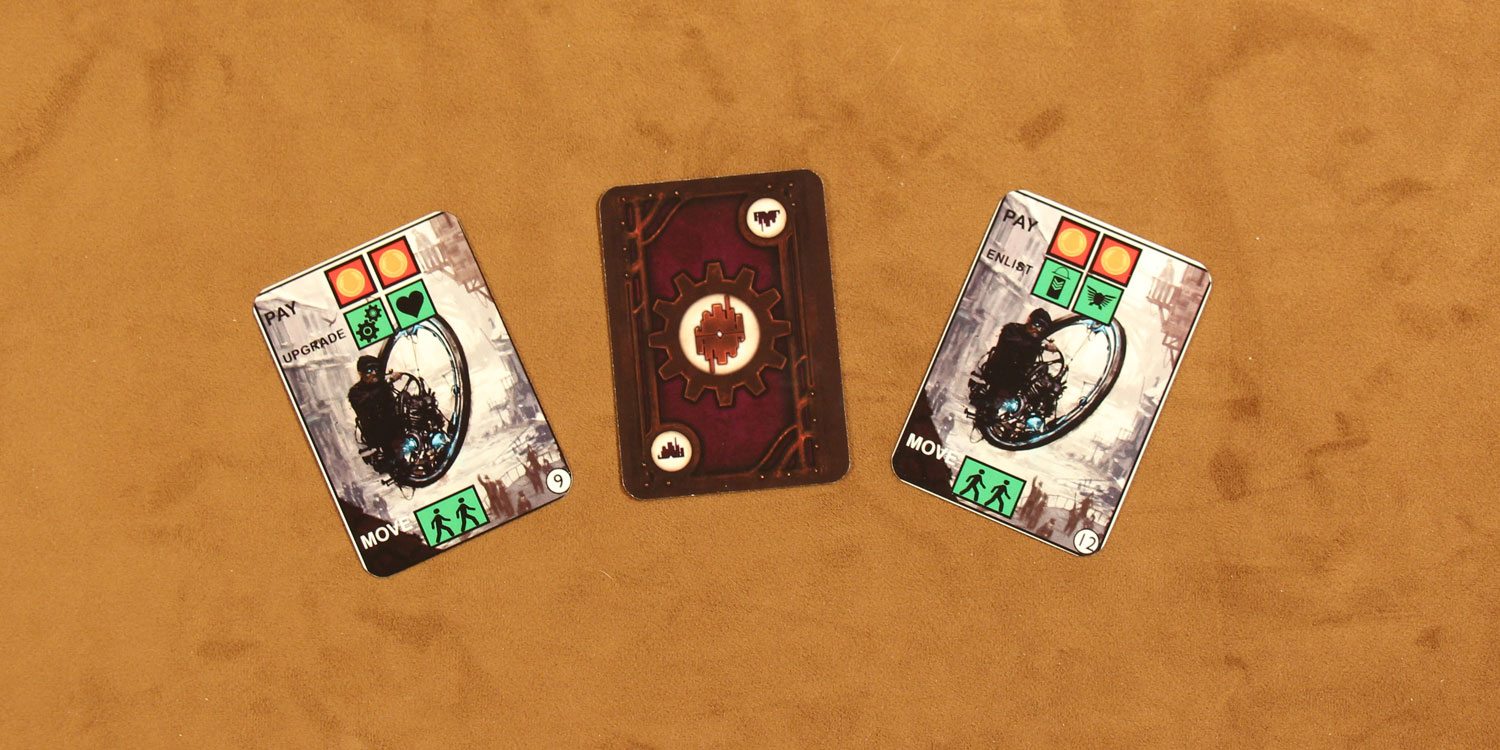
Important Concepts
There are a few important concepts that will help you understand the game.
- Territories are defined by hexes on the game board. Most have a resource that can be produced: oil from the tundra, metal from the mountains, wood from the forests, food from the farms, and workers from villages. There are three other hex types, none of which produce resources. Rivers and lakes are barriers and require tunnels or powers to cross them. The Factory is at the center of the board. Visiting it with your character gains you an extra action ability; occupying it at the end of the game can earn you bonus points. Finally, each player has a home base. Nothing is produced there and this is the space that a character/mechs/workers return(s) to after being vanquished in battle.
- Control is defined by having your character, mech, or a worker on a hex or if you have a building on a hex and no opponents occupying the same space. Only one faction can occupy a hex. Entering an occupied territory results in immediate combat.
- Resources produced go on the board. They can be carried from space to space by workers, but if a hex is conquered, any resources remain and become property of the faction that now controls the space. If you spend resources, they are removed from the board and returned to the supply.
- Workers are not resources. They can hitch a ride from space to space in a mech, they can produce resources, and build structures. Characters can engage in combat, have encounters, and gain Factory cards. Mechs can engage in combat and move workers. Units made from plastic can fight. Units made from wood cannot.
- Power is the metric that dictates combat. The power track goes up to 16, but only 7 can be used at one time (this number can be augmented by discarding a combat card for each mech involved in the current battle). Power from the power track and combat cards used in a battle are immediately lost after the outcome is decided.
- Stars represent achievements like deploying all your mechs or winning in combat, maxing out power or popularity. Once someone has placed all six of their stars, the game immediately ends.
- Popularity dictates how much the people of Europa like you. This is important because it serves as a multiplier at the end of the game when you convert stars, hexes controlled, and resources controlled to coins.
- Factions all have different powers and player mats all have variable costs and rewards.
Setup and Gameplay
There are four types of cards that get shuffled and placed on the board–objectives, encounters, combat, and factory. For the last group, take the number of players and add one–this is the number of factory cards that should be on the board–discard the rest.
Encounter tokens are placed on their corresponding symbols on the game board and a bonus tile is randomly selected and placed on the board. This shows how players can achieve bonus scoring at the end of the game. Resources and coins are placed within reach.
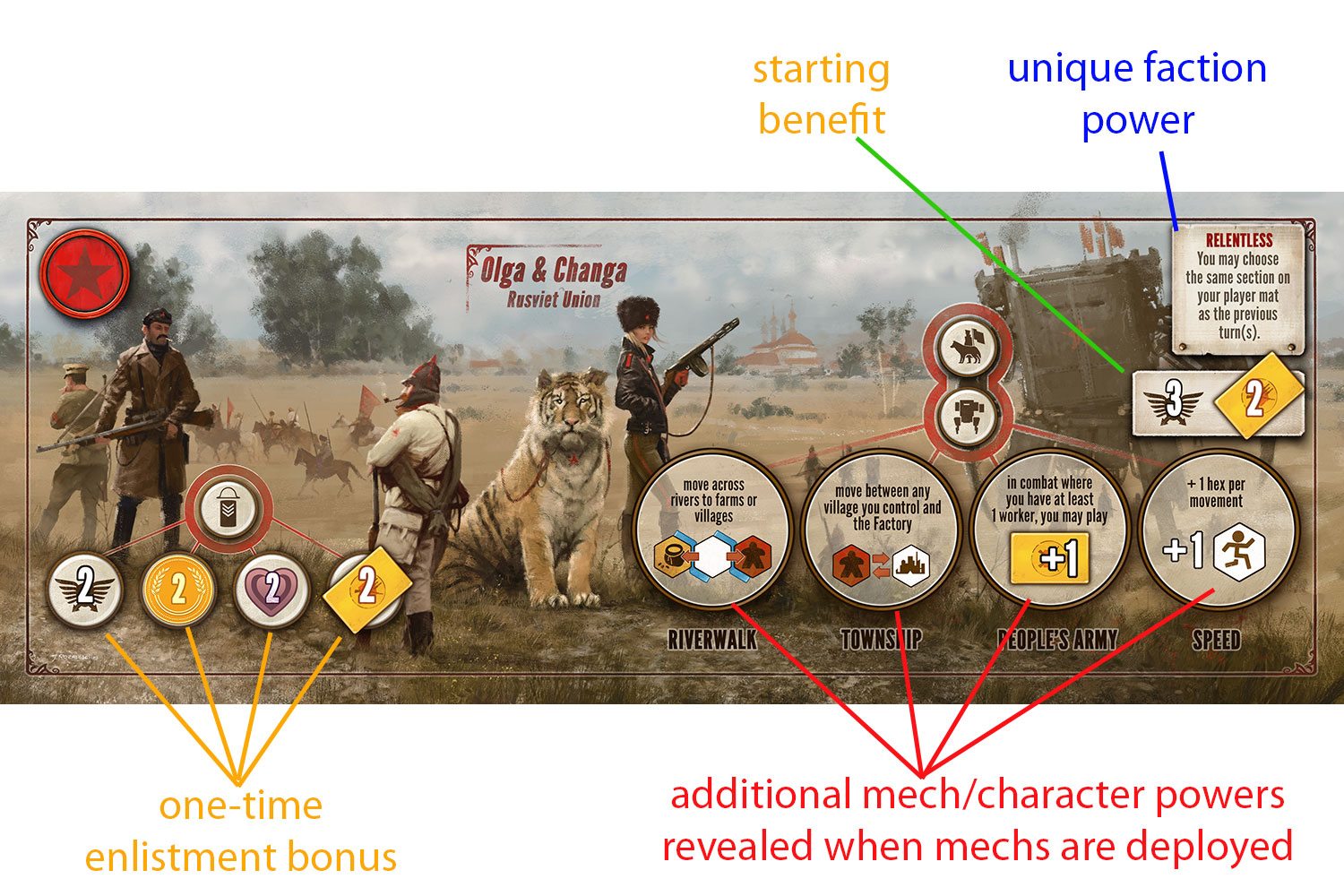
Faction mats and player mats are shuffled and then randomly distributed to players. Based on this distribution, players should sit near their home base. Starting power, money, and popularity are dictated by these cards, which also grant immediate and delayed/revealed powers. The faction mat is home to mechs waiting to enter the board and a player’s star tokens, which are applied after major game accomplishments.
The player mat is where a lot of the game happens. As you can see, it’s a little confusing at first, once all the wooden bits are added to the player mat, but it’s actually pretty simple. On a turn, a player chooses one of the four box segments and takes an action at the top of the box, bottom of the box, or both. Players can’t take the same action two turns in a row unless they have a power saying that they can. Red boxes are costs, green are benefits.
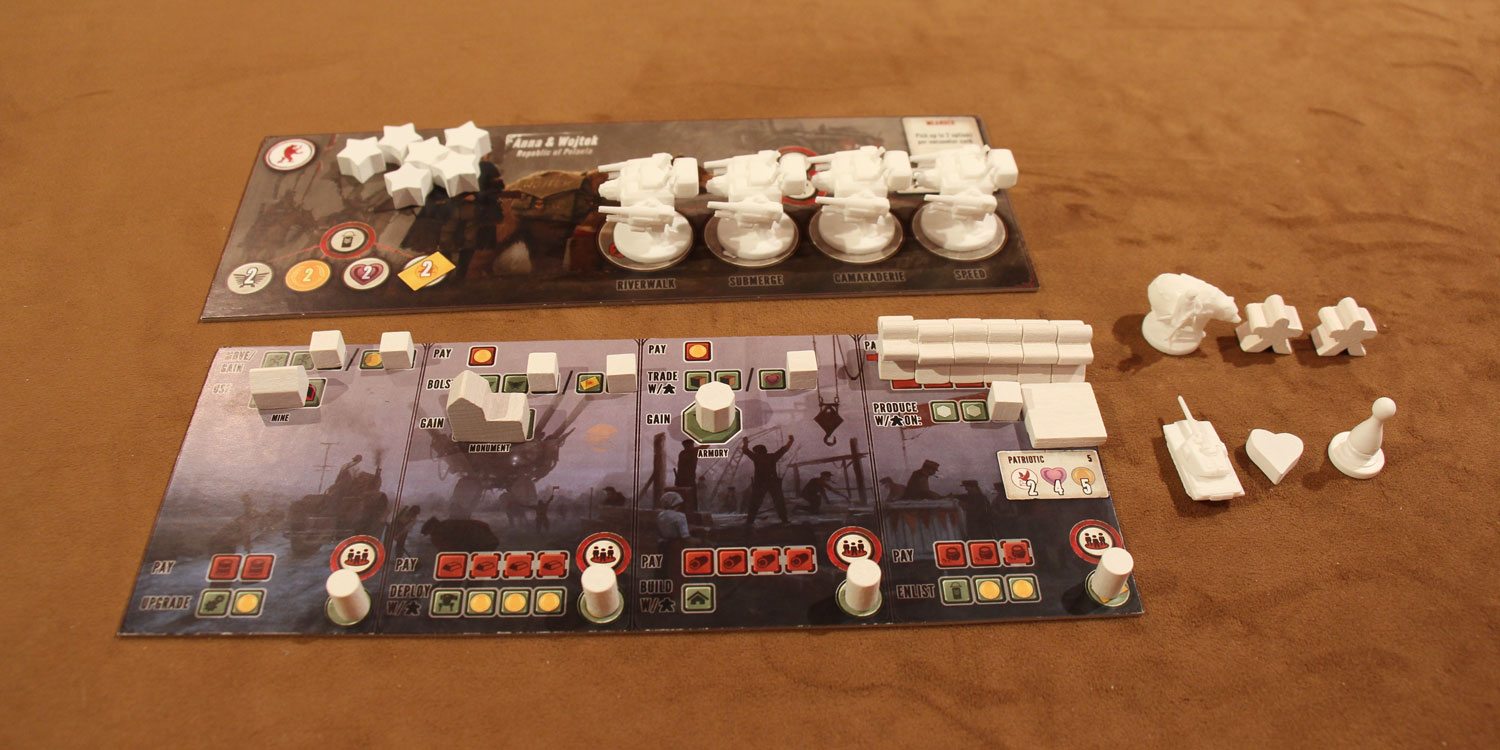
Players begin on their home bases with just a character and one worker in each adjacent hex (total of two workers). Each base is surrounded by three hexes and a river (not counting the unbridled wilderness of the two home bases for expansions). Players cannot leave this area until they build a tunnel, unless they have a special ability. This allows players to grow and strengthen a bit before venturing out into the harsh world.
The hexes around each home base vary, as do the production costs and ability to take actions, so this asymmetric game throws players curve balls from the very start. The first player is dictated by a number on the player mats and play continues clockwise from there.
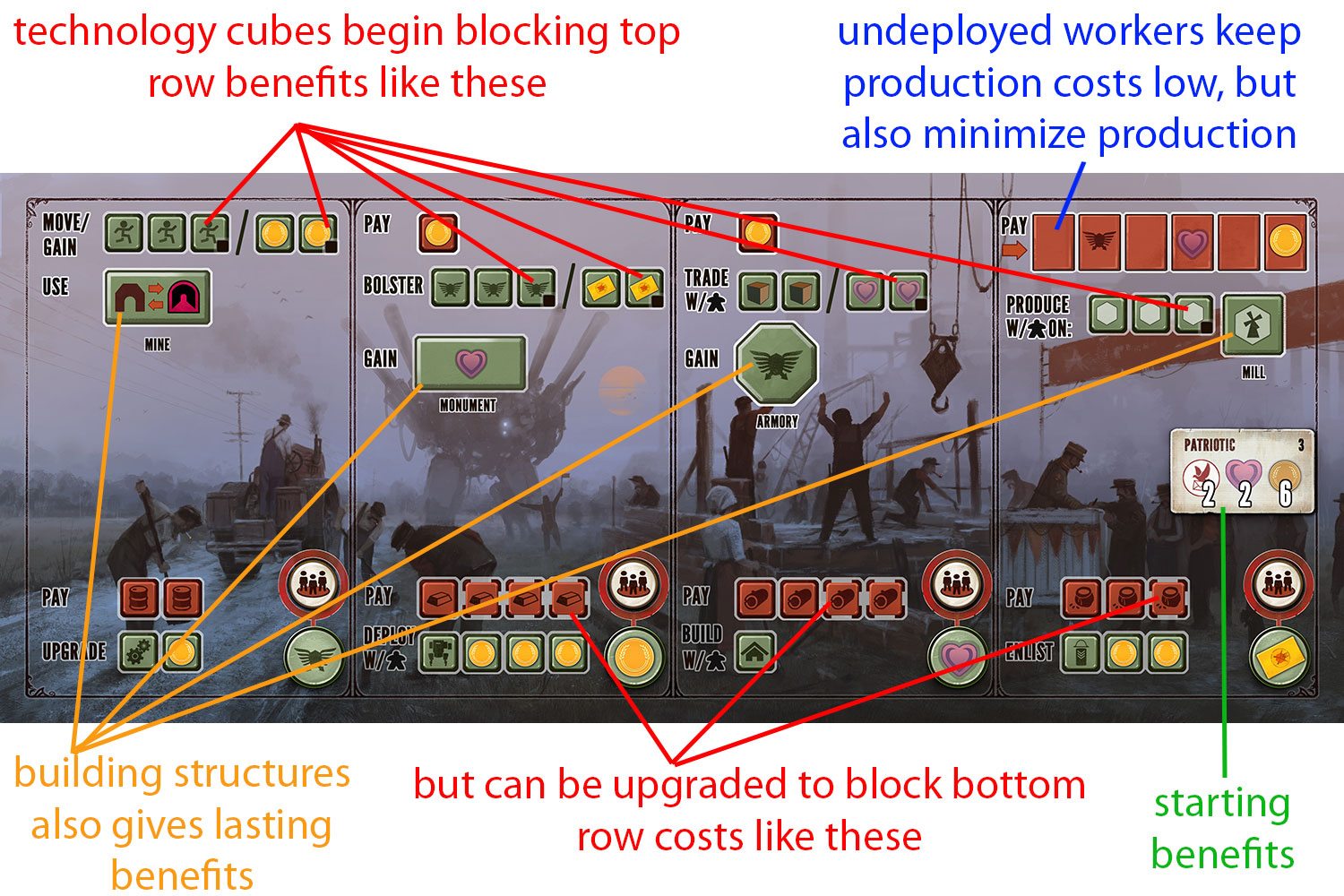
On a turn, players choose a new action from their player mat. They can do both top and bottom actions or just one of those. Top actions happen more frequently and among those actions, players can:
- Move – Move a number of units a single hex or gain coin(s).
- Bolster – Pay one coin and gain power on the power track or gain combat cards.
- Trade – Pay one coin and gain two resources or increase your popularity.
- Produce – Pay cost shown (power, popularity, coin, or all three, dependent on workers already deployed) and produce resources on a number of hexes.
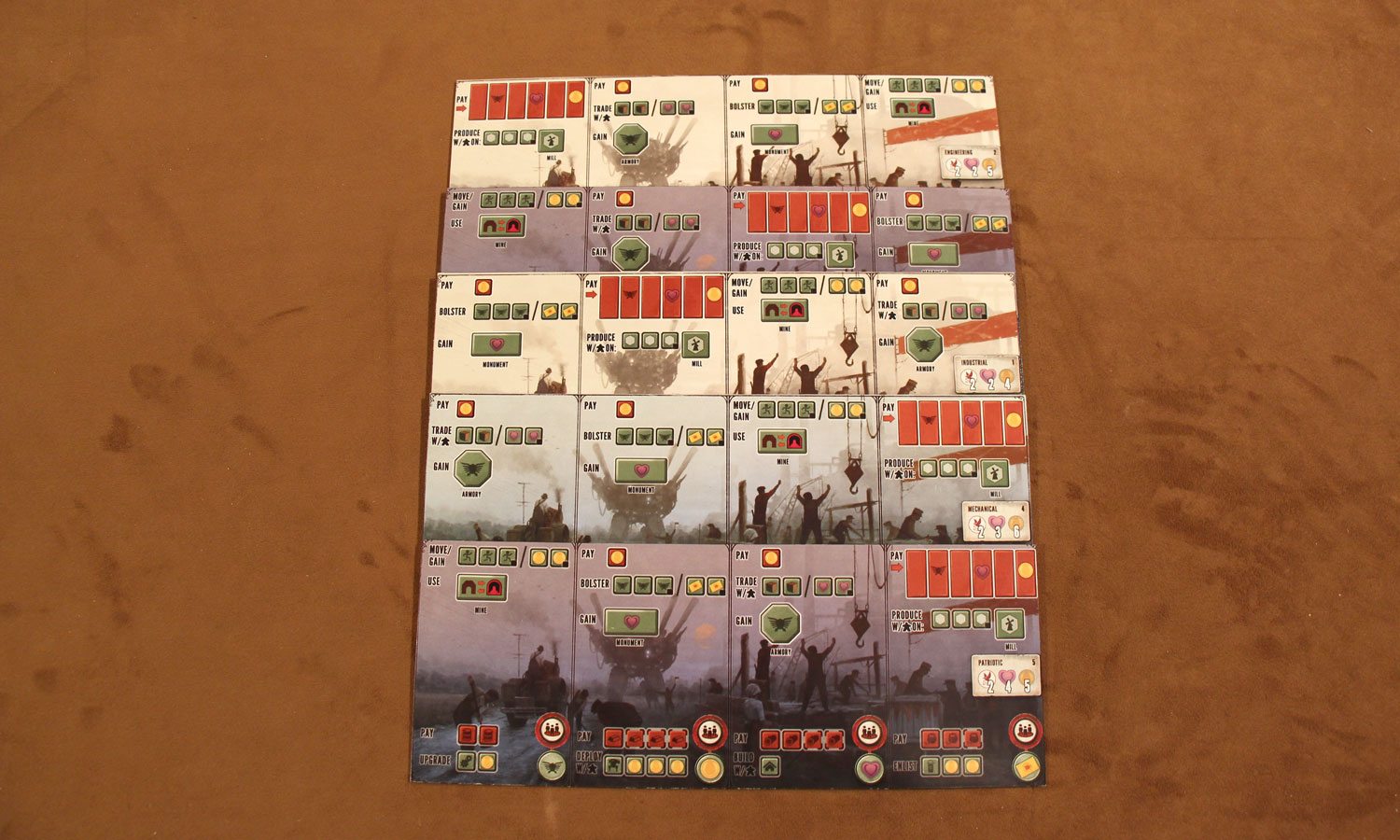
Additionally, there are bottom row actions that can be taken in place of or in addition to top row actions. When taking both actions, they must both be in the same segment of the player mat. What’s more, when taking a bottom row action, the next player may begin his turn as the player determines what to do with his bottom row action. These actions are:
- Upgrade – Pay the cost in oil. Move a technology cube from any top action green box and place it on any bracketed bottom action red box. This action makes bottom row actions cheaper, while increasing the payout of top row action benefits. Collect any coins your player mat provides.
- Deploy – Pay the cost in metal. Choose any mech on your faction mat and deploy it to a territory you control. When deploying a mech, it grants you an additional ability, revealed on your faction mat, so choose wisely. Collect any coins your player mat provides.
- Build – Pay the cost in wood. Build a structure. Collect any coins your player mat provides. There are four structures that can be built, each provides an additional benefit, as noted at the top row of your player mat.
- Enlist – Pay the cost in food and enlist recruits to join your faction. Recruits pay a one-time bonus (power, coin, popularity, combat cards) on your faction mat and an ongoing bonus to bottom row actions on your player mat.
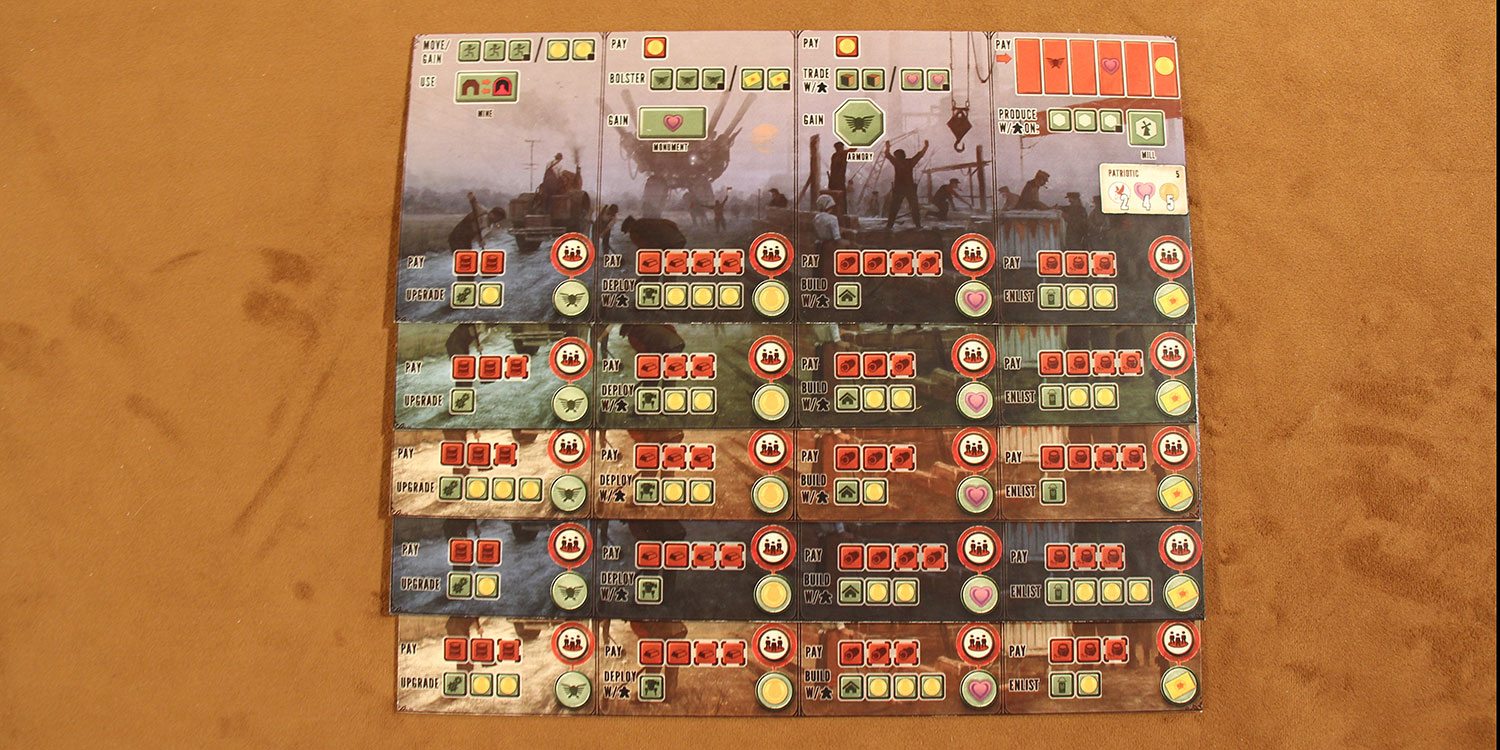
Players take turns choosing one or more of these actions, with an emphasis on cultivating their resources and size. When they feel bold or powerful enough, they can use the Build action to dig a mine beneath the river surrounding their home base and venture outwards. (One faction can traverse rivers without mines.) Out on the board, players can continue to expand and exploit the land, ever-building their empires. Since the number of controlled territories is one of the payouts at the end of the game, expansion will occur fairly rapidly with workers moving to hexes to take their resources and establish control. However, unprotected workers can be an invitation for nearby opposing characters or mechs and combat is always a looming threat.
When an opposing player moves his units onto a territory already in control by another player, combat occurs. Each picks up a power wheel and secretly turns the dial to a number between 0 and 7. This represents the number from the power track that each player is willing to sacrifice in this battle. Since the power track is available for all to see, a player with less than 7 power on the track is already revealing part of his strategy. Additionally, players may add on a combat card for each mech he controls in the current battle. Combat cards add between 2 and 5 points to the power wheel.
When ready, both players reveal their wheel and combat card(s). The winner stays on the hex and takes possession of any resources there. The loser takes all units back to his home base. Any buildings stay in place and the winner loses 1 popularity for each worker forced to retreat. However, the winner also may apply a star to the triumph track (for first two combat wins unless the player has a special ability).
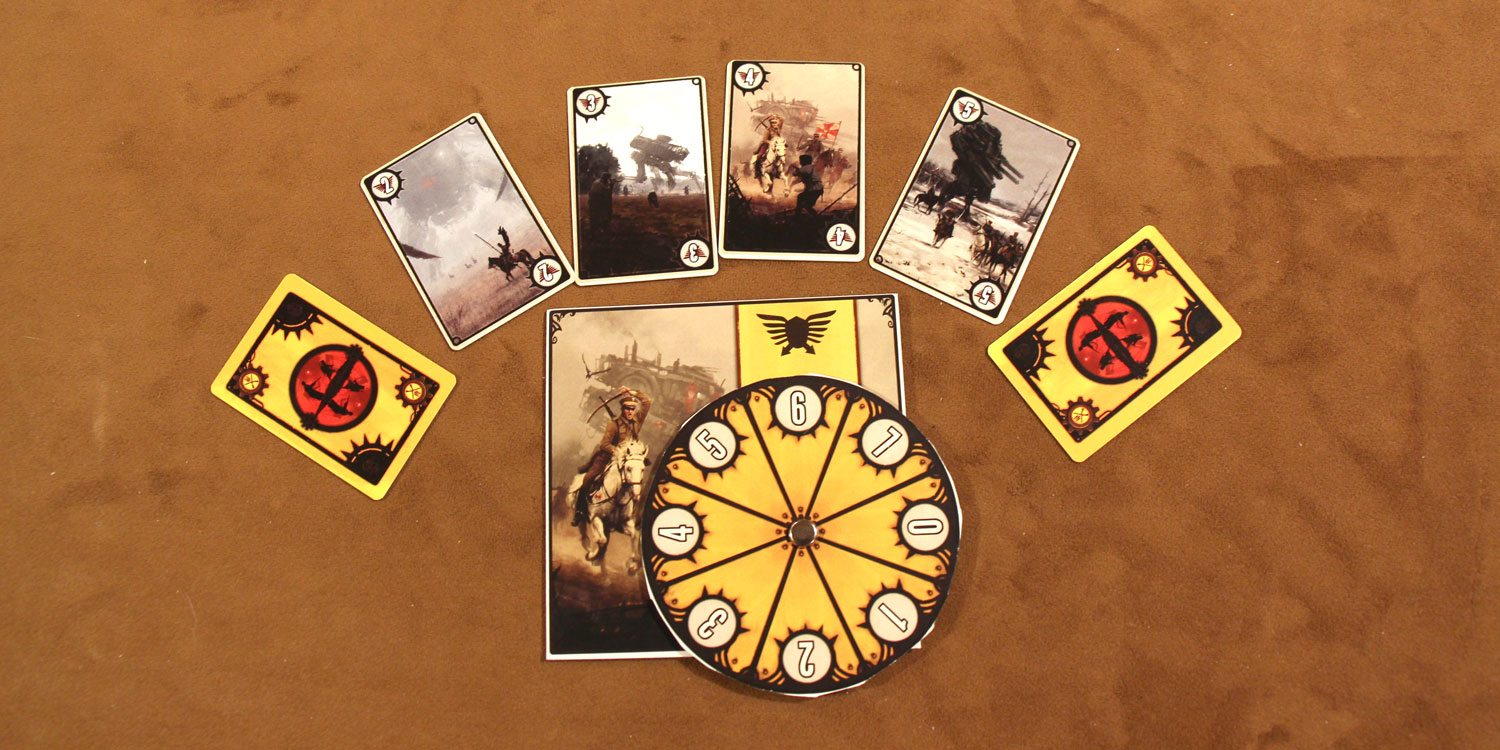
Arriving on certain territories, players can earn encounter cards, which provide several benefits, but the player can only choose one (again, unless another ability says otherwise–seeing a trend?). As mentioned before, visiting The Factory with a character gives players an additional action option, one that is often a significant improvement. And players all have two hidden objective cards. Complete the requirement on one of those cards, reveal it, and you can place a star on the triumph track. There is significantly more gameplay to Scythe than just this and there are quite a few if/then exceptions, but this constitutes the bulk of the game.
Play continues until someone places his sixth and final star, at which point the game immediately ends. Stars on the triumph track, territories controlled, and resources are all converted to coins, with a multiplier dependent on each player’s popularity. The bonus tile is resolved and the player with the most coins wins! And then, if you’re like my group, you talk about the game for 45 minutes before resetting the board and starting all over again.
Verdict
Wow, we really liked this game! Yes, the amount of bits in the box and the size of the rulebook were daunting at first. But after reading through and watching a video, it became very understandable. After the first few rounds, it seemed really easy. After that, it was just finding a strategy that worked… which was great for that game, but each time you play, you are faced with a random faction and player mat combination (and those of your opponents). It makes for an asymmetric game in many ways.
The home base you have is surrounded by territories that produce different resources than your opponents, in all likelihood. Your choice of objectives, the encounters you might run into, and your faction’s ability (and the discovered abilities when deploying mechs) all can have an effect on your strategy. Will you just harvest resources or dominate through combat? It’s a challenging problem and a fun one to try to solve.

Scythe is a game that’s about contrasts. It is complex in strategies and options, yet the action choices are fairly simple and the game is easy to pick up. The big selling point might be the menacing, war-bred mechs, but many games will be played without a single battle, such is the deterrent of sending home workers and the sense of Cold War détente. (Yes, using workers as a human shield is a valid strategy in Scythe.) The game board is huge, with more than 50 hexes, but territories are closer than they appear because of tunnel shortcuts. The box says games run 115 minutes, but we plowed through a 4-player game in only 75.
OK, the last one is a bit of a stretch, but I think there’s a lesson in it. We were enjoying Scythe so much, our turns were coming at a rapid-fire rate after a while. After just a few games, we had defined strategies enough that we had good ideas about what we wanted to do. (Not to say they were necessarily good strategies, mind you.) The rules state that, when taking a bottom level action, play can continue as the person makes his choice. It wasn’t unusual for someone to take a bottom level action and still be making up his mind when play came around the table and it was his turn again.
We played in combinations of 2, 3, and 4 players (never was able to find a 5th at the times we played). Two- and three- player games were mostly devoid of combat, but as the board got crowded with four players, combat became inevitable. We loved how there were benefits to winning combat, but also penalties, so that aggressors might be kept in check.
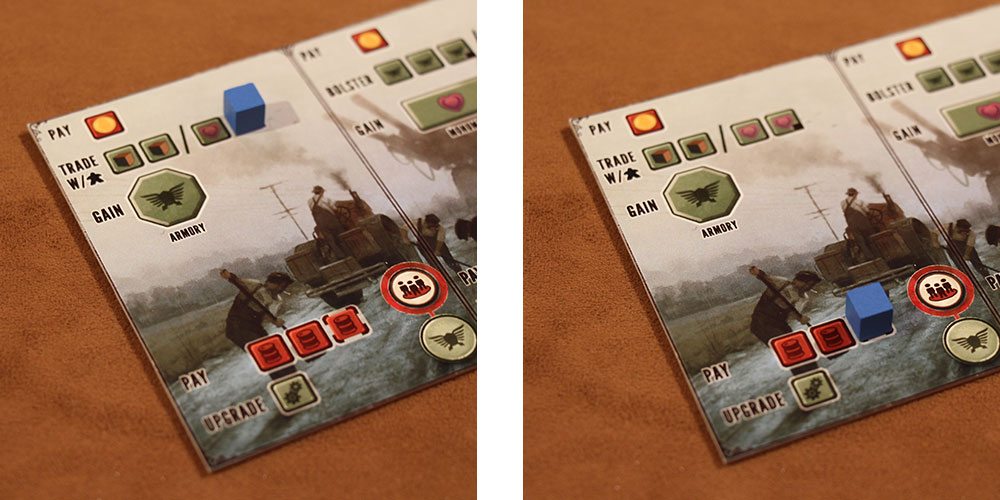
Part of the reason Scythe is so good is that it owes some of its design to a couple of tried and tested games. “Scythe is heavily inspired by Terra Mystica, which as of now has been #1 on my list of favorite games for quite a while,” says Scythe‘s designer, Jamey Stegmaier. “The key correlations between the two are the way the player mat works–you start with lots of tokens on your player mat, and your benefits improve during the game as you remove and move those tokens–and the constant feeling of being rewarded. Kemet is also a game I love, particularly the deterministic combat system and the way everything on the board is nearly equidistant to everything else. This is implemented in Scythe through a system of tunnels that allows the same board to be used for all player counts.”
There are parts that are reminiscent of Stonemaier’s other games, too. The popularity track is reminiscent, in ways, to the morale track in the outstanding game Euphoria. And like Kemet, Euphoria, and other great storytelling games, Scythe‘s story and theme are perfectly intertwined with gameplay. The cards, rulebook, and (especially) the artwork all work in kind with each other; building blocks that take Scythe beyond just a simple game story and creating its own universe with its own myths.
Is it all good and perfect? No… well… close. There are two things we didn’t like or wish were improved. First, the encounter cards are these big, beautiful murals with a lot going on, vignettes that are trying to tell a story and with action text at the bottom. The action text kind of adds to what’s going on, but we felt like adding a title to the cards to set the scene would have significantly improved the experience. In fact, we commented on it every time an encounter card was drawn. The storytelling in the rest of the game is so good and so well thought-out, it really feels like an oversight here.
Another thing is that one of the special abilities revealed when deploying the Polania faction mech permits Polania to force opposing builders to retreat (through combat only) without paying the popularity penalty. One of the things we especially liked about Scythe was the fact that combat always comes with a cost. Yes, you can force your opponents off their lands, but you will suffer a little because of it. Allowing one faction to engage in combat without penalty seemed overpowered to us and a touch unfair. As a one-time use, it would be acceptable, but as an ongoing effect, we didn’t care for it. In the future, we’ll probably tweak it as a house rule.
Still, these are obviously small complaints. Scythe is a fantastic game and I was really bummed out when I had to pack it up and send it on to the next reviewer. Certainly, it’s not a game every gamer will take to. I believe the age recommendation of 14 is pretty accurate. My 13-year-old son played it but had a bit of a tough time with strategy (and the game’s length). I am confident than the average casual gamer could easily grasp the rules if he had a good teacher, but a game so heavy on strategy and so light on luck might not hold his attention.
For me, Scythe is my new favorite game from Stonemaier (who have produced nothing but hits, so far). And like all Stonemaier’s games, Scythe comes with a money-back guarantee, so there’s really no risk in backing this project. It’s very enjoyable, both in gameplay and storytelling, which should make Jamey Stegmaier happy. “Even amidst other projects and responsibilities, Scythe has been my life over the last year. It started out as a passion project for Jakub, and it’s become just as personal to me, as well,” says Stegmaier. “Of course, what really matters is if people will have a fun, immersive experience with Scythe–for that I certainly have high hopes.”
Back Scythe today and you’ll be on your way to finding out how fun and immersive this game can really be.

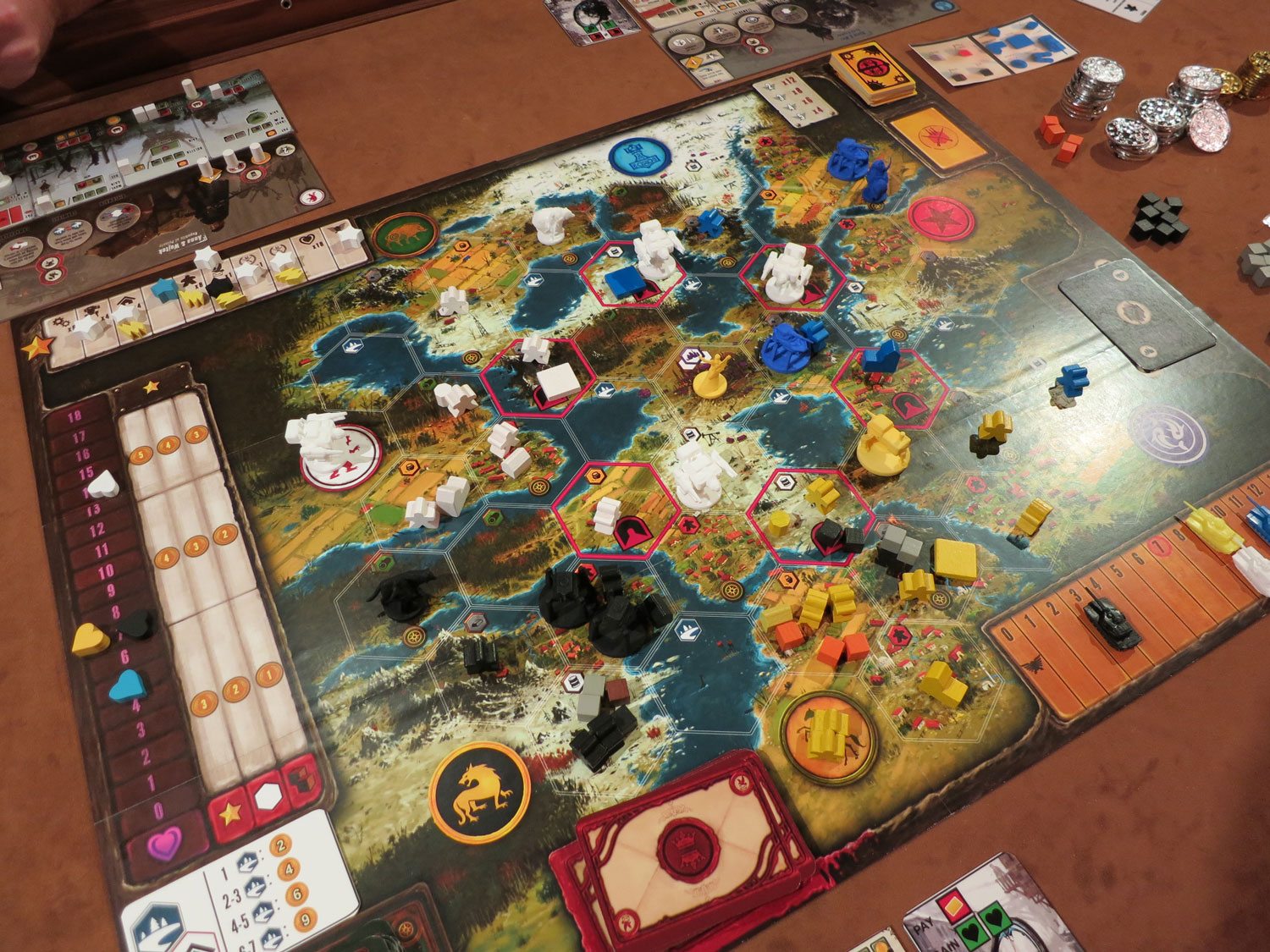
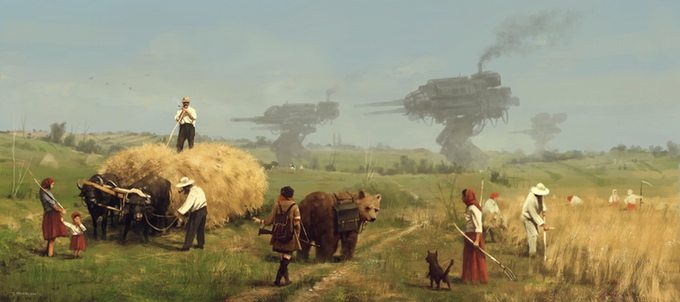

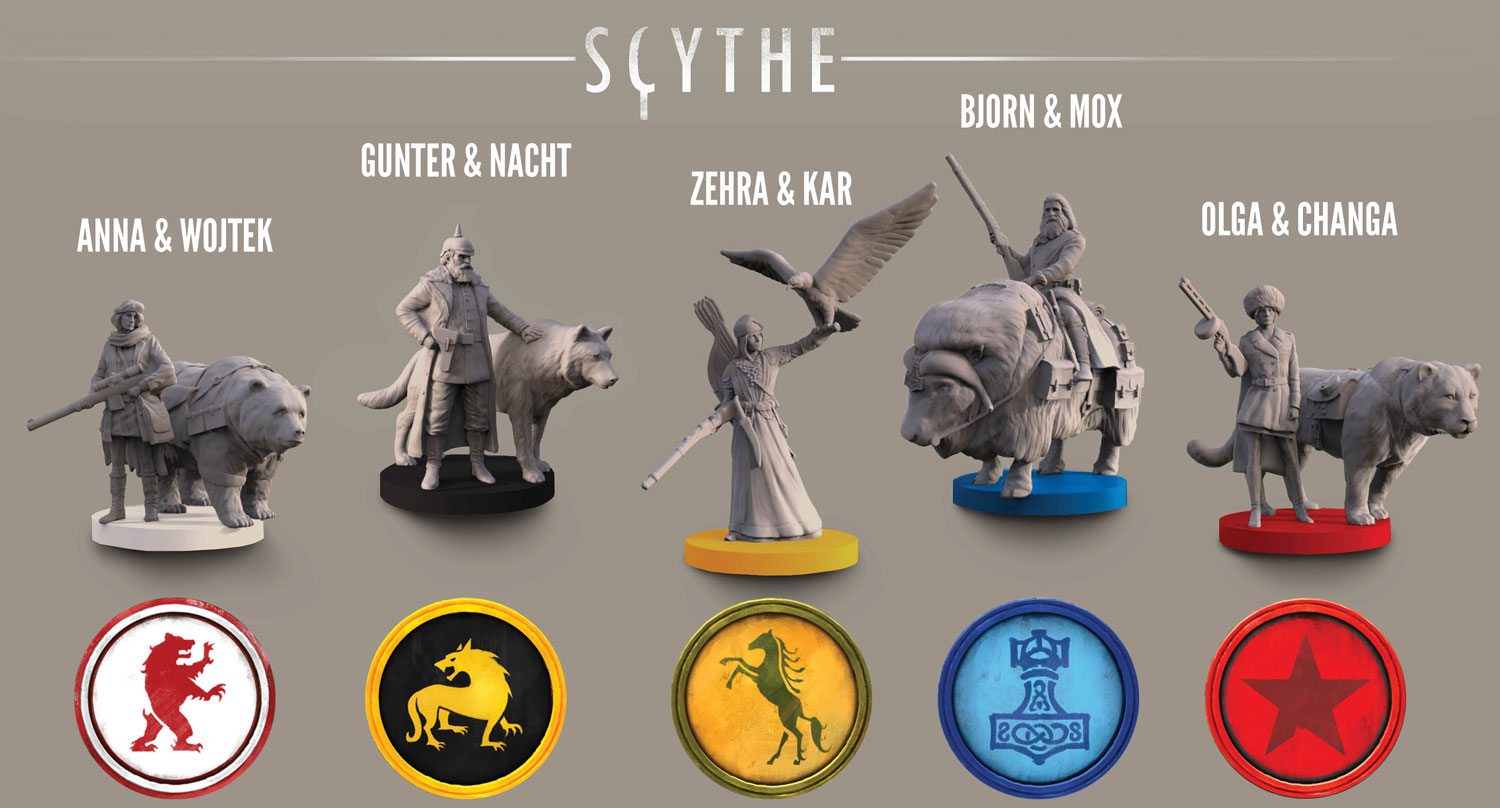
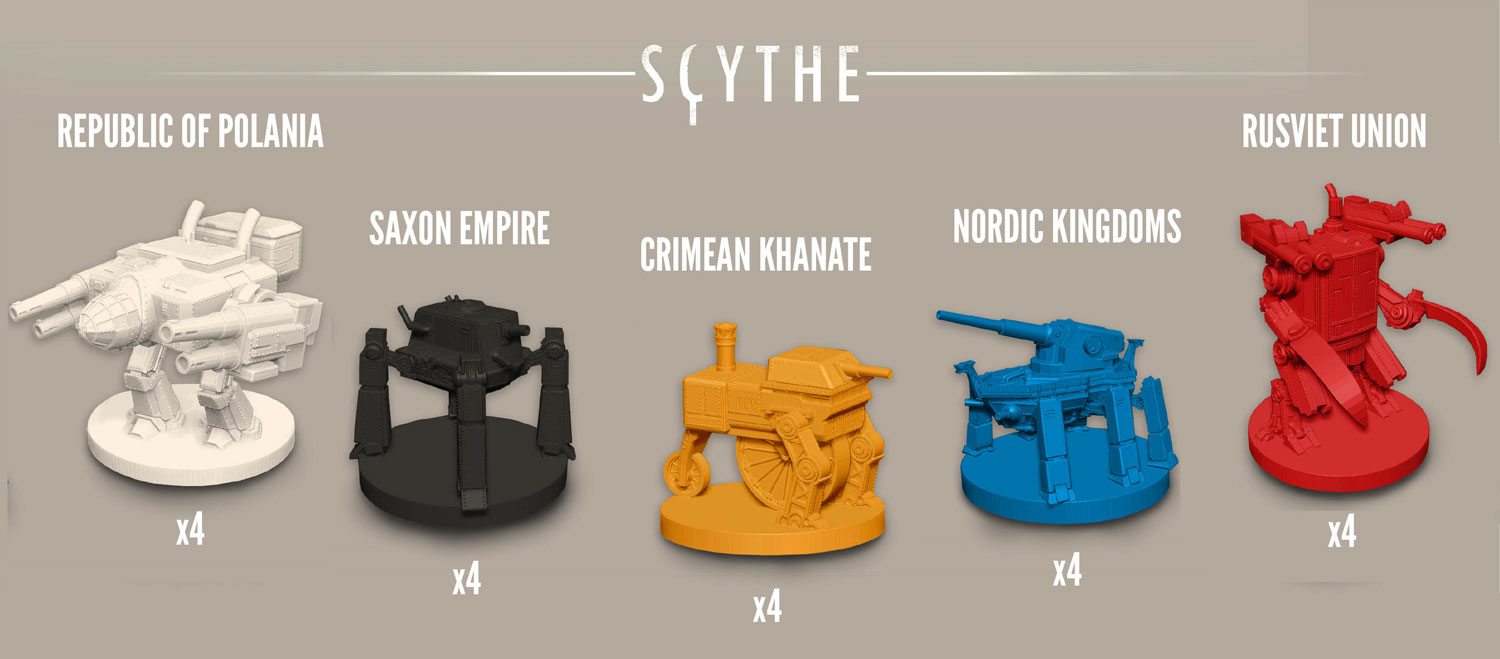


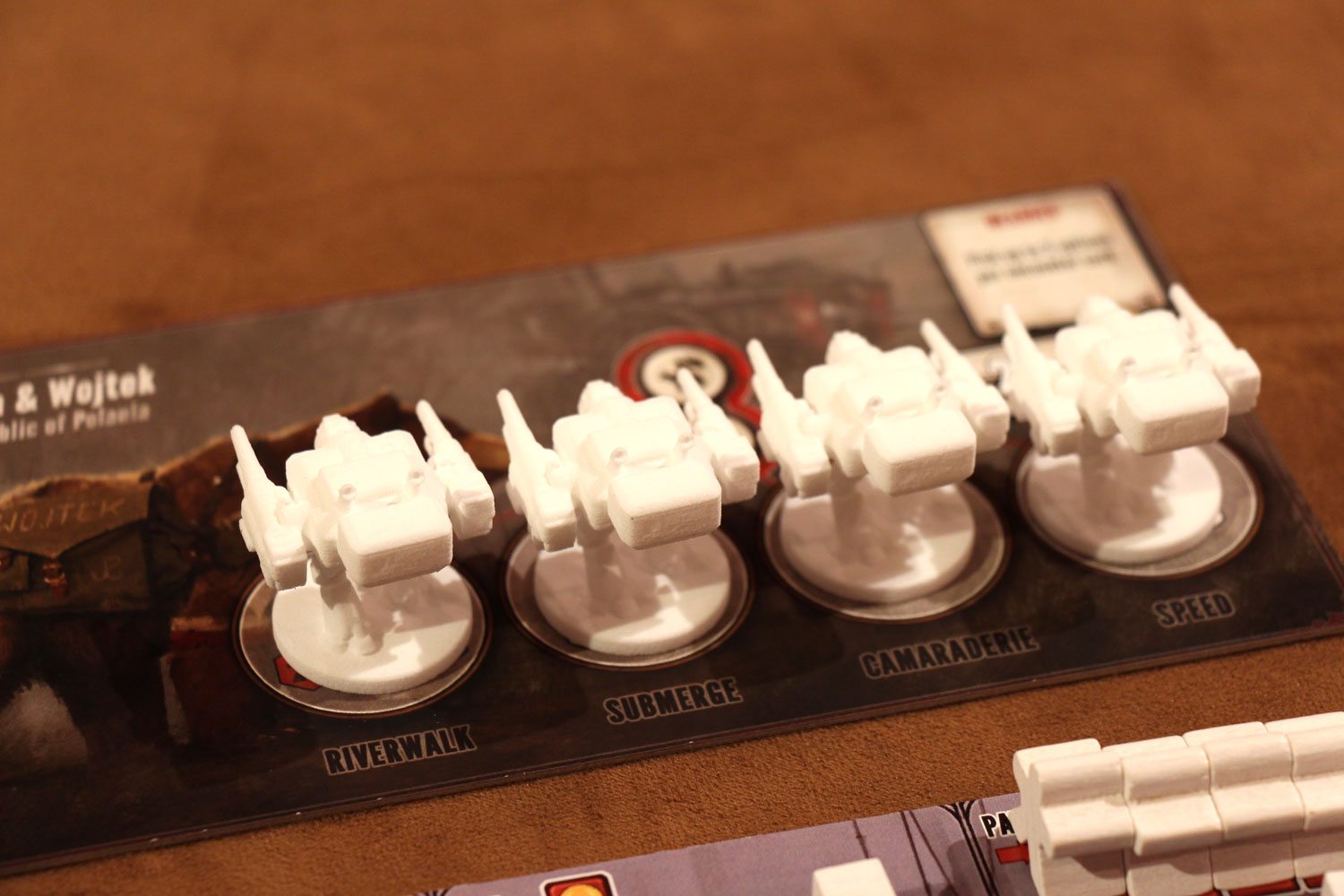


This looks superb. Due to the fact you seem to know what you’re talking about, I’d like to ask, is the game in it’s completely finished state? Are we waiting for the Kickstarter to finish, or would you reccomend purchasing it now? Anyhow, thanks for this easy to understand guide.